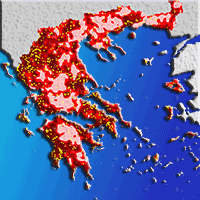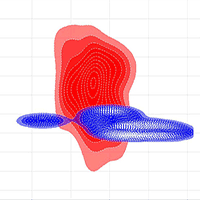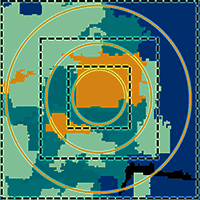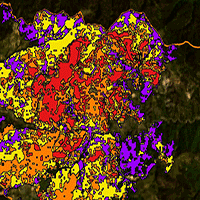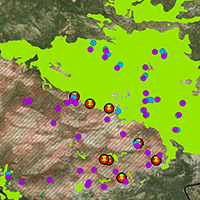This study proposes and evaluates a relatively new concept for fire occurrence zoning based on documented historical fire records. The proposed method creates continuous kernel density surfaces based on wildland fire ignition observations. Kernels have the advantage of directly producing density estimates that are not influenced by grid size or localization effects. Within this scheme, kernel density surfaces have been created and reclassified to construct fire occurrence zones at local to global scales in the Mediterranean Basin. Specifically, fire occurrence zones were created for the European scale (European Mediterranean Basin), national scale (Greece), regional scale (Peloponnese, Greece) and local scale (Chalkidiki, Greece). To evaluate fire occurrence zones, we compared the observed with the expected distribution of the number of fires within these zones using a Monte Carlo randomization test, finding that these numbers were statistically different in all cases. The deviations observed from the expected distributions towards the high occurrence zone indicated their successful assessment and value. In this paper, we further discuss their potential role and use for multi-scale fire management and policy in a European context.
Keywords
, , , , , ,
Citation
Koutsias N, Allgöwer B, Kalabokidis K, Mallinis G, Balatsos P, Goldammer JG (2015). Fire occurrence zoning from local to global scale in the European Mediterranean basin: implications for multi-scale fire management and policy. iForest 9: 195-204. - doi: 10.3832/ifor1513-008
Academic Editor
Davide Ascoli
Paper history
Received: Nov 24, 2014
Accepted: Sep 11, 2015
First online: Nov 12, 2015
Publication Date: Apr 26, 2016
Publication Time: 2.07 months
© SISEF - The Italian Society of Silviculture and Forest Ecology 2015
Open Access
This article is distributed under the terms of the Creative Commons Attribution-Non Commercial 4.0 International (https://creativecommons.org/licenses/by-nc/4.0/), which permits unrestricted use, distribution, and reproduction in any medium, provided you give appropriate credit to the original author(s) and the source, provide a link to the Creative Commons license, and indicate if changes were made.

Breakdown by View Type
(Waiting for server response...)
Article Usage
Total Article Views: 55696
(from publication date up to now)
Breakdown by View Type
HTML Page Views: 45753
Abstract Page Views: 4055
PDF Downloads: 4532
Citation/Reference Downloads: 44
XML Downloads: 1312
Web Metrics
Days since publication: 3682
Overall contacts: 55696
Avg. contacts per week: 105.89
Article Citations
Article citations are based on data periodically collected from the Clarivate Web of Science web site
(last update: Mar 2025)
Total number of cites (since 2016): 26
Average cites per year: 2.60
Publication Metrics
by Dimensions ©
Articles citing this article
List of the papers citing this article based on CrossRef Cited-by.
(1)
Allgöwer B, Koutsias N, Benvenuti M, Blanchi R, Bonora L, Chuvieco E, Conese C, Godfrin V, Heikkila T, Kauppinen T, Martín P, Martínez J, Martínez Fernandez J, Ribeiro L-M, Viegas DX (2004)Fire risk and human factors (III), The human factor in fire occurrence (Part 3), Fire Occurrence Analysis Methods (Part 3), The Wildland Urban Interface (WUI) (Part 2). Deliverable no. 143, SPREAD Project, pp. 129.
Gscholar
(2)
Amatulli G, Peréz-Cabello F, De La Riva J (2007)Mapping lightning/human-caused wildfires occurrence under ignition point location uncertainty. Ecological Modelling 200 (3-4): 321-333.
CrossRef |
Gscholar
(3)
Amatulli G, Rodrigues MJ, Trombetti M, Lovreglio R (2006)Assessing long-term fire risk at local scale by means of decision tree technique. Journal of Geophysical Research G: Biogeosciences 111 (4).
CrossRef |
Gscholar
(4)
Badia A, Serra P, Modugno S (2011)Identifying dynamics of fire ignition probabilities in two representative Mediterranean wildland-urban interface areas. Applied Geography 31 (3): 930-940.
CrossRef |
Gscholar
(5)
Bailey TC, Gatrell AC (1995)Interactive spatial data analysis (1st edn). Longman Scientific and Technical, Essex, UK, pp. 413.
Online |
Gscholar
(6)
Bajocco S, Ricotta C (2008)Evidence of selective burning in Sardinia (Italy): which land-cover classes do wildfires prefer? Landscape Ecology 23 (2): 241-248.
CrossRef |
Gscholar
(7)
Bar Massada A, Syphard AD, Stewart SI, Radeloff VC (2013)Wildfire ignition-distribution modelling: a comparative study in the Huron-Manistee National Forest, Michigan, USA. International Journal of Wildland Fire 22 (2): 174-183.
CrossRef |
Gscholar
(8)
Bedia J, Herrera S, Camia A, Moreno JM, Gutiérrez JM (2014)Forest fire danger projections in the Mediterranean using ENSEMBLES regional climate change scenarios. Climatic Change 122 (1-2): 185-199.
CrossRef |
Gscholar
(9)
Bradstock RA, Hammill KA, Collins L, Price O (2010)Effects of weather, fuel and terrain on fire severity in topographically diverse landscapes of south-eastern Australia. Landscape Ecology 25 (4): 607-619.
CrossRef |
Gscholar
(10)
Calkin DE, Ager AA, Thompson MP, Finney MA, Lee DC, Quigley TM, McHugh CW, Riley KL, Gilbertson-Day JM (2011)A comparative risk assessment framework for wildland fire management: the 2010 cohesive strategy science report. General Technical Report RMRS-GTR 262, USDA Forest Service, Fort Collins, CO, USA, pp. 1-63.
Gscholar
(11)
Castillo Soto ME (2012)The identification and assessment of areas at risk of forest fire using fuzzy methodology. Applied Geography 35 (1-2): 199-207.
CrossRef |
Gscholar
(12)
Castro R, Chuvieco E (1998)Modeling forest fire danger from geographic information systems. Geocarto International 13 (1): 15-23.
CrossRef |
Gscholar
(13)
Catry FX, Rego FC, Bação FL, Moreira F (2009)Modeling and mapping wildfire ignition risk in Portugal. International Journal of Wildland Fire 18 (8): 921-931.
CrossRef |
Gscholar
(14)
Chen X (2007)Spatial pattern of wildfire occurrences in Alabama, USA. International Journal of Environmental Studies 64 (2): 229-242.
CrossRef |
Gscholar
(15)
Chuvieco E, Aguado I, Yebra M, Nieto H, Salas J, Martín MP, Vilar L, Martínez J, Martín S, Ibarra P, De La Riva J, Baeza J, Rodríguez F, Molina JR, Herrera MA, Zamora R (2010)Development of a framework for fire risk assessment using remote sensing and geographic information system technologies. Ecological Modelling 221 (1): 46-58.
CrossRef |
Gscholar
(16)
Cochrane MA, Moran CJ, Wimberly MC, Baer AD, Finney MA, Beckendorf KL, Eidenshink J, Zhu Z (2012)Estimation of wildfire size and risk changes due to fuels treatments. International Journal of Wildland Fire 21 (4): 357-367.
CrossRef |
Gscholar
(17)
Conedera M, Torriani D, Neff C, Ricotta C, Bajocco S, Pezzatti GB (2010)Using Monte Carlo simulations to estimate relative fire ignition danger in a low-to-medium fire-prone region. Forest Ecology and Management 261 (12): 2179-2187.
CrossRef |
Gscholar
(18)
De La Riva J, Pérez-Cabello F, Lana-Renault N, Koutsias N (2004)Mapping forest fire occurrence at a regional scale. Remote Sensing of Environment 92 (3): 363-369.
CrossRef |
Gscholar
(19)
Fernandes PM (2013)Fire-smart management of forest landscapes in the Mediterranean basin under global change. Landscape and Urban Planning 110: 175-182.
CrossRef |
Gscholar
(20)
Fernandes PM, Davies GM, Ascoli D, Fernández C, Moreira F, Rigolot E, Stoof CR, Vega JA, Molina D (2013)Prescribed burning in southern Europe: developing fire management in a dynamic landscape. Frontiers in Ecology and the Environment 11 (s1): e4-e14.
CrossRef |
Gscholar
(21)
Fried JS, Gilless JK, Spero J (2006)Analysing initial attack on wildland fires using stochastic simulation. International Journal of Wildland Fire 15 (1): 137-146.
CrossRef |
Gscholar
(22)
Galiana-Martin L, Herrero G, Solana J (2011)A wildland-urban interface typology for forest fire risk management in Mediterranean areas. Landscape Research 36 (2): 151-171.
CrossRef |
Gscholar
(23)
Ganteaume A, Camia A, Jappiot M, San-Miguel-Ayanz J, Long-Fournel M, Lampin C (2013)A review of the main driving factors of forest fire ignition over Europe. Environmental Management 51 (3): 651-662.
CrossRef |
Gscholar
(24)
Harris S, Nicholls N, Tapper N (2013)Forecasting fire activity in Victoria, Australia, using antecedent climate variables and ENSO indices. International Journal of Wildland Fire 23 (2): 173-184.
CrossRef |
Gscholar
(25)
Jelinski DE, Wu J (1996)The modifiable areal unit problem and implications for landscape ecology. Landscape Ecology 11 (3): 129-140.
CrossRef |
Gscholar
(26)
Kalabokidis K, Xanthopoulos G, Moore P, Caballero D, Kallos G, Llorens J, Roussou O, Vasilakos C (2012)Decision support system for forest fire protection in the Euro-Mediterranean region. European Journal of Forest Research 131 (3): 597-608.
CrossRef |
Gscholar
(27)
Kalabokidis KD, Koutsias N, Konstantinidis P, Vasilakos C (2007)Multivariate analysis of landscape wildfire dynamics in a Mediterranean ecosystem of Greece. Area 39 (3): 392-402.
CrossRef |
Gscholar
(28)
Koutsias N, Kalabokidis KD, Allgöwer B (2002)Fire occurrence patterns at landscape level: beyond positional accuracy of ignition points with kernel density estimation methods. In: Proceedings of the “2002 World Conference on Natural Resources Modeling - Modeling Natural and Biotic Resources in a Changing Planet”. Sigri (Lesbos, Greece) 23-26 June 2002 [poster].
Gscholar
(29)
Koutsias N, Kalabokidis KD, Allgöwer B (2004)Fire occurrence patterns at landscape level: beyond positional accuracy of ignition points with kernel density estimation methods. Natural Resource Modeling 17 (4): 359-375.
CrossRef |
Gscholar
(30)
Koutsias N, Karteris M, Balatsos P, Kalabokidis KD (2005)Strategic planning approach in wildland fire danger zoning: a geographical perspective with historical fire observations. Geographies 10: 62-79.
Gscholar
(31)
Koutsias N, Martínez-Fernández J, Allgower B (2010)Do factors causing wildfires vary in space? Evidence from geographically weighted regression. GIScience and Remote Sensing 47 (2): 221-240.
CrossRef |
Gscholar
(32)
Koutsias N, Arianoutsou M, Kallimanis AS, Mallinis G, Halley JM, Dimopoulos P (2012)Where did the fires burn in Peloponnisos, Greece the summer of 2007? Evidence for a synergy of fuel and weather. Agricultural and Forest Meteorology 156: 41-53.
CrossRef |
Gscholar
(33)
Koutsias N, Xanthopoulos G, Founda D, Xystrakis F, Nioti F, Pleniou M, Mallinis G, Arianoutsou M (2013)On the relationships between forest fires and weather conditions in Greece from long-term national observations (1894-2010). International Journal of Wildland Fire 22 (4): 493-507.
CrossRef |
Gscholar
(34)
Koutsias N, Balatsos P, Kalabokidis KD (2014)Fire occurrence zones: kernel density estimation of historical wildfire ignitions at the national level, Greece. Journal of Maps 10 (4): 630-639.
CrossRef |
Gscholar
(35)
Laris P (2011)Humanizing savanna biogeography: linking human practices with ecological patterns in a frequently burned savanna of southern Mali. Annals of the Association of American Geographers 101 (5): 1-22.
CrossRef |
Gscholar
(36)
Lee B, Park PS, Chung J (2006)Temporal and spatial characteristics of forest fires in South Korea between 1970 and 2003. International Journal of Wildland Fire 15 (3): 389-396.
CrossRef |
Gscholar
(37)
Manly BF, McDonald TL, Thomas DL, Erickson WP (2010)Resource selection by animals: statistical design and analysis for field studies. Springer, New York, USA, pp. 222.
Online |
Gscholar
(38)
Martínez-Fernández J, Chuvieco E, Koutsias N (2013)Modelling long-term fire occurrence factors in Spain by accounting for local variations with geographically weighted regression. Natural Hazards and Earth System Sciences 13 (2): 311-327.
CrossRef |
Gscholar
(39)
Martínez J, Vega-García C, Chuvieco E (2009)Human-caused wildfire risk rating for prevention planning in Spain. Journal of Environmental Management 90 (2): 1241-1252.
CrossRef |
Gscholar
(40)
Massada AB, Radeloff VC, Stewart SI, Hawbaker TJ (2009)Wildfire risk in the wildland-urban interface: a simulation study in northwestern Wisconsin. Forest Ecology and Management 258: 1990-1999.
CrossRef |
Gscholar
(41)
McInerney D, San-Miguel-Ayanz J, Corti P, Whitmore C, Giovando C, Camia A (2013)Design and function of the European forest fire information system. Photogrammetric Engineering and Remote Sensing 79 (10): 965-973.
CrossRef |
Gscholar
(42)
Miller C, Ager AA (2013)A review of recent advances in risk analysis for wildfire management. International Journal of Wildland Fire 22 (1): 1-14.
CrossRef |
Gscholar
(43)
Montiel-Molina C (2013)Comparative assessment of wildland fire legislation and policies in the European Union: towards a fire framework directive. Forest Policy and Economics 29: 1-6.
CrossRef |
Gscholar
(44)
Moreira F, Rego FC, Ferreira PG (2001)Temporal (1958-1995) pattern of change in a cultural landscape of northwestern Portugal: implications for fire occurrence. Landscape Ecology 16 (6): 557-567.
CrossRef |
Gscholar
(45)
Moreira F, Viedma O, Arianoutsou M, Curt T, Koutsias N, Rigolot E, Barbati A, Corona P, Vaz P, Xanthopoulos G, Mouillot F, Bilgili E (2011)Landscape-wildfire interactions in Southern Europe: implications for landscape management. Journal of Environmental Management 92: 2389-2402.
CrossRef |
Gscholar
(46)
Moreno JM, Vallejo VR, Chuvieco E (2013)Current fire regimes, impacts and the likely changes - VI: Euro Mediterranean. In: “Vegetation Fires and Global Change: Challenges for Concerted International Action” (Goldammer JG ed). White Paper, Global Fire Monitoring Center (GFMC), Kessel Publishing House, Remagen, Germany, pp. 115-131.
Online |
Gscholar
(47)
Moreno JM, Vázquez A, Veléz R (1998)Recent history of forest fires in Spain. In: “Large Forest Fires” (Moreno JM ed). Backhuys Publishers, Leiden, the Netherlands, pp. 159-185.
Gscholar
(48)
Moreno JM, Viedma O, Zavala G, Luna B (2011)Landscape variables influencing forest fires in central Spain. International Journal of Wildland Fire 20 (5): 678-689.
CrossRef |
Gscholar
(49)
Oliveira S, Oehler F, San-Miguel-Ayanz J, Camia A, Pereira JMC (2012)Modeling spatial patterns of fire occurrence in Mediterranean Europe using multiple regression and random forest. Forest Ecology and Management 275: 117-129.
CrossRef |
Gscholar
(50)
Oliveira S, Pereira JMC, San-Miguel-Ayanz J, Lourenço L (2014)Exploring the spatial patterns of fire density in southern Europe using geographically weighted regression. Applied Geography 51: 143-157.
CrossRef |
Gscholar
(51)
Openshaw S (1984)The modifiable areal unit problem. Concepts and Techniques in Modern Geography 38 (38): 41.
Gscholar
(52)
Palaiologou P, Kalabokidis K, Kyriakidis P (2013)Forest mapping by geoinformatics for landscape fire behaviour modelling in coastal forests, Greece. International Journal of Remote Sensing 34 (12): 4466-4490.
CrossRef |
Gscholar
(53)
Pausas J, Fernández-Muñoz S (2012)Fire regime changes in the western Mediterranean Basin: from fuel-limited to drought-driven fire regime. Climatic Change 110 (1-2): 215-226.
CrossRef |
Gscholar
(54)
Pérez B, Cruz A, Fernández-González F, Moreno JM (2003)Effects of the recent land-use history on the postfire vegetation of uplands in central Spain. Forest Ecology and Management 182 (1-3): 273-283.
CrossRef |
Gscholar
(55)
Perry JN, Dixon PM (2002)A new method to measure spatial association for ecological count data. Ecoscience 9 (2): 133-141.
Online |
Gscholar
(56)
Pezzatti GB, Bajocco S, Torriani D, Conedera M (2009)Selective burning of forest vegetation in Canton Ticino (southern Switzerland). Plant Biosystems 143 (3): 609-620.
CrossRef |
Gscholar
(57)
Podur J, Martell DL, Csillag F (2003)Spatial patterns of lightning-caused forest fires in Ontario, 1976-1998. Ecological Modelling 164: 1-20.
CrossRef |
Gscholar
(58)
Pyne SJ, Andrews PL, Laven RD (1996)Introduction to wildland fire (2nd edn). John Wiley and Sons Inc., New York, USA, pp. 769.
Online |
Gscholar
(59)
Rideout DB, Omi PN (1990)Alternate expressions for the economic theory of forest fire management. Forest Science 36 (3): 614-624.
Online |
Gscholar
(60)
Rodrigues M, De La Riva J (2014)An insight into machine-learning algorithms to model human-caused wildfire occurrence. Environmental Modelling and Software 57: 192-201.
CrossRef |
Gscholar
(61)
Rodrigues M, De La Riva J, Fotheringham S (2014)Modeling the spatial variation of the explanatory factors of human-caused wildfires in Spain using geographically weighted logistic regression. Applied Geography 48: 52-63.
CrossRef |
Gscholar
(62)
Salis M, Ager AA, Arca B, Finney MA, Bacciu V, Duce P, Spano D (2013a)Assessing exposure of human and ecological values to wildfire in Sardinia, Italy. International Journal of Wildland Fire 22 (4): 549-565.
CrossRef |
Gscholar
(63)
Salis M, Ager AA, Finney MA, Arca B, Spano D (2013b)Analyzing spatiotemporal changes in wildfire regime and exposure across a Mediterranean fire-prone area. Natural Hazards 71 (3): 1389-1418.
CrossRef |
Gscholar
(64)
San-Miguel-Ayanz J, Schulte E, Schmuck G, Camia A (2013)The European Forest Fire Information System in the context of environmental policies of the European Union. Forest Policy and Economics 29: 19-25.
CrossRef |
Gscholar
(65)
Santini M, Collalti A, Valentini R (2014)Climate change impacts on vegetation and water cycle in the Euro-Mediterranean region, studied by a likelihood approach. Regional Environmental Change: 1-14.
CrossRef |
Gscholar
(66)
Seaman DE, Powell RA (1996)An evaluation of the accuracy of kernel density estimators for home range analysis. Ecology 77 (7): 2075-2085.
CrossRef |
Gscholar
(67)
Sebastián-López A, Salvador-Civil R, Gonzalo-Jiménez J, SanMiguel-Ayanz J (2008)Integration of socio-economic and environmental variables for modelling long-term fire danger in Southern Europe. European Journal of Forest Research 127 (2): 149-163.
CrossRef |
Gscholar
(68)
Syphard AD, Keeley JE, Brennan TJ (2011)Comparing the role of fuel breaks across southern California national forests. Forest Ecology and Management 261 (11): 2038-2048.
CrossRef |
Gscholar
(69)
Thompson MP, Calkin DE, Finney MA, Ager AA, Gilbertson-Day JW (2011)Integrated national-scale assessment of wildfire risk to human and ecological values. Stochastic Environmental Research and Risk Assessment 25 (6): 761-780.
CrossRef |
Gscholar
(70)
Tsiourlis G, Andreadakis S, Konstantinidis P (2009)SITHON: a wireless network of
in situ optical cameras applied to the early detection-notification-monitoring of forest fires. Sensors 9 (6): 4465-4482.
CrossRef |
Gscholar
(71)
Turco M, Llasat M-C, Von Hardenberg J, Provenzale A (2014)Climate change impacts on wildfires in a Mediterranean environment. Climatic Change: 1-12.
CrossRef |
Gscholar
(72)
Vazquez A, Moreno JM (1998)Patterns of lightning-, and people-caused fires in Peninsular Spain. International Journal of Wildland Fire 8 (2): 103-115.
CrossRef |
Gscholar
(73)
Vázquez A, Moreno JM (2001)Spatial distribution of forest fires in Sierra de Gredos (Central Spain). Forest Ecology and Management 147 (1): 55-65.
CrossRef |
Gscholar
(74)
Viedma O (2008)The influence of topography and fire in controlling landscape composition and structure in Sierra de Gredos (Central Spain). Landscape Ecology 23 (6): 657-672.
CrossRef |
Gscholar
(75)
Viedma O, Angeler DG, Moreno JM (2009)Landscape structural features control fire size in a Mediterranean forested area of central Spain. International Journal of Wildland Fire 18 (5): 575-583.
CrossRef |
Gscholar
(76)
Viedma O, Moity N, Moreno JM (2015)Changes in landscape fire-hazard during the second half of the 20th century: agriculture abandonment and the changing role of driving factors. Agriculture, Ecosystems and Environment 207: 126-140.
CrossRef |
Gscholar
(77)
Viegas DX, Bovio G, Ferreira A, Nosenzo A, Sol B (1999)Comparative study of various methods of fire danger evaluation in southern Europe. International Journal of Wildland Fire 9 (4): 235-246.
CrossRef |
Gscholar
(78)
Viegas DX, Allgöwer B, Koutsias N, Eftichidis G (2003)Fire spread and the urban wildland interface problem. In: Proceedings of the “International Workshop on Forest Fires in the Wildland-Urban Interface and Rural Areas in Europe: an integral planning and management challenge” (Xanthopoulos G ed). Athens (Greece) 15-16 May 2003. Mediterranean Agronomic Institute of Chania (MAICh), Hania, Greece, pp. 93-103.
Online |
Gscholar
(79)
Vilar Del Hoyo L, Isabel MPM, Vega FJM (2011)Logistic regression models for human-caused wildfire risk estimation: analysing the effect of the spatial accuracy in fire occurrence data. European Journal of Forest Research 130 (6): 983-996.
CrossRef |
Gscholar
(80)
Worton BJ (1989)Kernel methods for estimating the utilization distribution in home-range studies. Ecology 70 (1): 164-168.
CrossRef |
Gscholar
(81)
Xystrakis F, Koutsias N (2013)Differences of fire activity and their underlying factors among vegetation formations in Greece. iForest - Biogeosciences and Forestry 6 (1): 132-140.
CrossRef |
Gscholar
